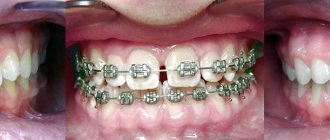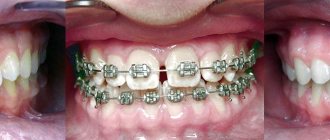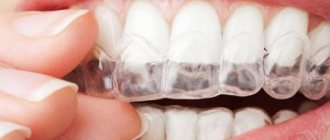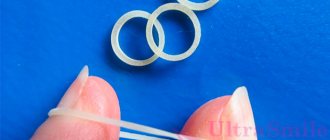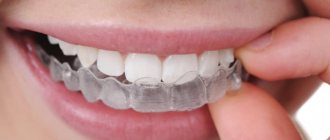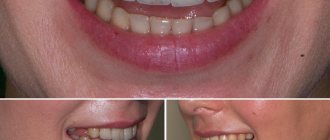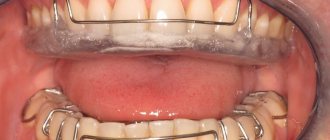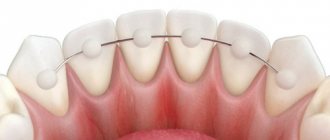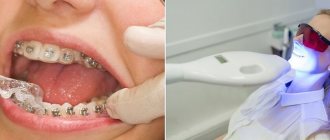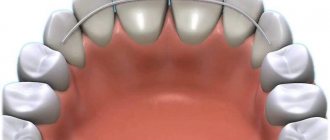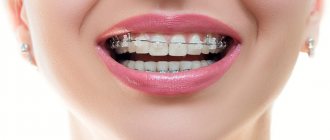Treating a malocclusion is not the easiest dental problem. And wearing braces is only the first stage of correcting the relationship of the dentition. The moment of removing braces from already perfect teeth cannot be considered the end of successful treatment. After removal of the treatment structures, artificially moved teeth can gradually acquire the same incorrect position again. The reason is that the human body resists in every possible way external mechanical influences exerted on it from the outside. And as soon as the auxiliary structures are removed, the teeth will gradually begin to acquire their former curvature.
Dental mouthguards are needed to prevent such regression. These designs are very carefully selected for each person. A correctly selected mouthguard is made strictly according to the individual dimensions of the patient. This lightweight and comfortable device helps keep teeth in their new position without causing discomfort. They are used for final bite alignment for people of any age. In addition, mouth guards also protect the dentition from external influences, thereby keeping the teeth unharmed. Let's remember boxers who are not allowed to train or compete without special dental guards.
WHY IS IT IMPORTANT TO WEAR MOWS AFTER REMOVING BRACES?
Most patients are unaware that straightening teeth using braces is only the first stage of complex restorative treatment. However, being encouraged by the results should not prevent you from continuing treatment.
If you neglect the need to resort to wearing removable orthodontic structures, the teeth will again begin to occupy their previous incorrect position.
And then all the work done, money and time spent on straightening teeth will be in vain.
Overconfidence will result in such a patient having to have braces installed again to realign the teeth.
REASONS FOR THE RISK OF REPEATED BITE DISORDERS
To understand why you need to wear mouthguards after removing braces, you need to know the basics of the anatomy of the maxillofacial apparatus. Many ignorant patients do not understand why this step cannot be avoided. After all, all the problems are behind us, those around us admire the attractive smile of the owner of straight and white teeth. And then, it turns out, everything can change again for the worse. So what is the reason?
It's all about the structural features of the teeth. The teeth are surrounded by a space in which the ligaments and vessels that hold them in the jaws are located. With the help of braces, the ligaments are stretched and the teeth move in the jaw in the right directions. This is associated with a feeling of pain in the area of the fixed teeth during the period of bite correction. Stretched ligaments strive to return the teeth to their original position, but dental structures interfere with them. However, after removing the braces, nothing prevents the ligamentous apparatus of the teeth from taking their original positions. It is to inhibit this natural process that special devices or mouth guards are used.
Fixed retainers
They are also often called lingual retainers because they are located on the inside of the teeth, next to the tongue, and are therefore completely invisible to others. Fixed retainers are used to secure single-rooted front teeth, and their design is quite simple. A non-removable retainer is a thin hidden metal arch, point-glued from the inner surface to each tooth with filling material.
Fixed retainer
Designed to maintain the stable position of single-rooted teeth (canines and incisors).
A non-removable retainer can only be installed and removed by an orthodontist and requires careful preparation of the surface (professional cleaning of plaque). The better the inner surface of the teeth is prepared, the less likely it is that the retainer will come off. A fixed retainer is much easier to clean than braces: just use a toothbrush (mechanical, electric or ultrasonic - the one you are used to), a small dental brush and dental floss.
WHAT IS A RETENTION CAP
Mouth guards (or aligners) for teeth are removable devices in the form of plastic overlays that fit onto the teeth. These clear braces are designed to hold teeth in a given position. They are made in such a way that they can be removed during oral care or the devices themselves. Mouthguards for teeth after braces are used in the following cases:
- at the time of teeth formation in childhood;
- for minor malocclusions;
- to avoid relapses after removing braces.
Aligners (or aligners) are made from special high-quality material that is harmless and does not cause allergic reactions. Thanks to the biopolymer material, the manufactured plates are transparent, light, and invisible.
The materials for the manufacture of these structures are hypoallergenic and do not harm the body in any way.
Also, mouthguards do not injure the mucous membranes of the oral cavity and do not cause noticeable discomfort.
Patients adapt very quickly to wearing mouth guards. This is due to their convenience, perfect fit and the ability to quickly remove. Mouthguards do not interfere with eating, talking, and can be easily removed and put on by their owner. Colored polymers are sometimes used for children. After all, it is more difficult for a child than for an adult to explain the need and importance of the retention period. To ensure that children enjoy wearing the necessary dental structures, they are often offered colored mouth guards. Such aligners are perceived by children as unusual decorations and often become the envy of their peers.
Mouthguards cannot be used instead of braces, as they can only correct minor malocclusions.
If mouthguards are prescribed to a patient as the main type of treatment, this means that he has minimal problems with the alignment of his teeth. In such cases, the aligners are changed several times, bringing the teeth closer and closer to their ideal.
Timely placement of aligners not only maintains a positive result, but also reduces the period of use of braces.
How does the installation process work?
A retainer after braces is placed in the doctor's office. The process takes place in several stages:
- Preparation of the oral cavity. First you need to make sure that years of wearing braces have not damaged the enamel. The doctor also checks for the presence of caries, removes plaque, and applies a protective layer to the enamel;
- Manufacturing of a retention apparatus. Since retainers are placed on specific teeth, they are usually made specifically for the patient.
- The wire-tire is fixed with special composite materials.
In the video below you can see how retainers are installed using the indirect fixation method.
If we are talking about a mouthguard, you can put it on yourself. But usually the doctor controls the process, because this helps to adjust the dental retainer to the shape of the jaw. There are models that are made to order, and there are thermally modeled ones that can be adjusted to the bite after heating.
TYPES OF RETENTIONAL KAPS
In the vast ocean of modern retention guards, the following types can be distinguished:
- Standard: manufactured according to a single sample. This type is inexpensive. The disadvantage of such devices is that they are not ideal for everyone. Therefore, it can be problematic to perfectly fix this type of mouth guard.
- Thermoplastic: They are made of a material that becomes plastic when immersed in hot water. In this state, the plastic mass is applied to the dentition, after which it takes the shape of the jaw and hardens.
- Individual: this is the most advanced type of removable structures, which is ideally adjusted to the patient’s jaws. Such mouthguards are made from plaster casts that are taken from the patient’s dentition. Ready-made mouthguards completely repeat the shape of each person’s jaw, taking into account all the tubercles, irregularities and all the anatomical features of the teeth. Typically, the average production time for such structures is about a week. But the result, as a rule, satisfies even the most capricious patients. The only drawback of this type of mouthguard is their high cost.
The use of computer technology allows us to produce ultra-precise aligners such as Invisalign and ClearCorrect. This type of mouthguard fits perfectly to the teeth, repeats all the irregularities of the teeth and is the most advanced (albeit expensive).
Regular standard mouth guards are affordable, but sometimes cause discomfort. They are often combined with non-removable wire retainers, which increase the effectiveness of treatment. Wire structures are attached to the inside of the teeth and remain invisible.
Removable retainers
Under removable retainers
refers to designs that can be removed and put on independently. With removable retainers, it is easy to clean your teeth; you do not need to contact the orthodontist again if you need a filling, etc. A removable retainer also allows you to maintain the position of your teeth if a problem arises with a fixed retainer - it breaks partially or completely, and you are far from your orthodontist. The doctor may also recommend a removable retainer if the patient is missing one or more teeth (eighth teeth or wisdom teeth are not taken into account).
There are several types of removable retainers - plates, aligners and positioners. The plates consist of a plastic base and metal fixing elements - arches along the front teeth and loops on the chewing teeth. Thanks to the rigid base, the plate can fix the new width of the dental arch. The disadvantage of such a retainer is that it will be noticeable to others, so most often doctors prescribe the use of a retention plate at home and at night.
HOW LONG DO YOU WEAR MOWS AFTER BRACES?
Only a doctor can confidently say how long mouthguards should be worn after braces. Usually they develop the necessary scheme for wearing mouth guards, which helps maintain the correct bite and minimizes the patient’s inconvenience.
As a rule, wearing retention guards starts from two hours a day.
After some time (usually several weeks), it is enough to wear these designs only at night. Often, overnight removable structures are used for several months. In the future, it will be enough to use dental veneers 2-3 times a week. After a year and a half, it is usually enough to use aligners once a week. The specialist supervising the process of correcting the patient’s bite should talk about all this in detail.
What determines the time of wearing removable dental structures after removing braces?
- Depending on the type and degree of malocclusion (if the pathology is more serious, the time of wearing the appliances will be longer).
- Patients over 30 years of age usually require more time to wear the aligners. The older the patient is, the more difficult it is to keep his teeth in the correct position. In children, the maxillofacial apparatus has not yet been formed and is more easily susceptible to various manipulations to change it.
- Many experts consider it necessary to wear mouthguards for a long time (at least 1.5-2 years).
Often the period of wearing aligners corresponds to twice the period of wearing the previous braces.
The longer a person has worn braces, the more time they will need to use the aligners. Some orthodontists adhere to the theory of wearing these structures for the longest possible time (for several years).
Which system to choose
No one except the orthodontist can decide which device is suitable for the patient. The selection of the system is carried out strictly individually, taking into account the characteristics of the clinical situation.
In the most difficult cases, it may be necessary to use two types of mechanisms at once. So, a person wears retainers on his teeth around the clock, and at night he additionally puts on a mouth guard to increase the pressure created.
NUANCES WHEN WEARING A KAP
There are some inconveniences to wearing mouth guards that patients need to be aware of. Here are the main ones:
- At first, the mouthguards may cause slight discomfort. However, after some time, most patients get used to these devices. Wearing soft aligners does not cause pain (unlike wearing braces).
The only reason for pain during treatment with mouth guards is if the patient has not worn them for some time.
This signals that the teeth are trying to take their original incorrect position.
- At first, wearing mouthguards often causes patients to have defects in the pronunciation of various sounds (usually hissing and whistling).
- Most aligners are made from clear polymers. Wearing them usually remains unnoticed and does not cause a stir among colleagues or relatives.
- Some patients get tired of wearing mouth guards for long periods of time. And then some people allow themselves a little break from using aligners. But in advance I would like to warn patients against such a frivolous attitude towards this stage of treatment.
Even if you don’t wear mouth guards for one day, they begin to have difficulty fitting onto your teeth.
This suggests that in the absence of retaining structures, the teeth immediately begin to “move”, that is, they try to take the wrong position again. Therefore, if you stop wearing mouth guards for braces, this can negate all the efforts and remedies of the entire treatment to straighten your bite.
Popular questions
Can a mouthguard be used instead of braces?
Mouthguards are used to correct malocclusions, but they are not suitable for all clinical cases. Serious anomalies cannot be corrected with their help: this requires braces or a combined approach, in which plates are used only at the final stage of treatment.
The mouth guard is cracked, what should I use to seal it?
You should not try to repair or seal a cracked or chipped mouth guard yourself: a broken device can damage your teeth. If you find mechanical damage to the mouthguard, you must stop wearing it and consult your doctor.
Mouthguard care
No particularly complicated care is required for the aligners. However, it is necessary to monitor the condition of the structures and maintain oral hygiene from the first days of wearing this device.
The main thing is to follow a number of rules that should become a habit. Here are the main ones:
- To avoid deformation, mouthguards should not be exposed to high temperatures. It is strictly forbidden to use boiling, steaming, using hot water or drying over hot surfaces to disinfect aligners. It is also not recommended to drink too hot drinks or food while wearing a mouthguard.
To keep the polymer pad clean, it should be cleaned with a regular toothbrush and rinsed with water.
- For cleaning, use the same toothpaste as for brushing your teeth. It is best to clean your aligners in the morning, evening and afternoon, if possible. If the aligners are not cleaned for a long time, an unpleasant taste appears in the mouth, and food debris accumulates under the plastic structures.
- Even if the patient did not wear the mouth guards during the day, it is better to wash and clean them in the evening (to prevent the growth of serious pathogenic bacteria). After all, it is prohibited to use any type of heat treatment for plastic mouthguards.
- Sometimes experts recommend special solutions that disinfect the pad and prevent it from becoming covered with plaque.
- It is very convenient to use special cases for caring for mouthguards and carrying them. The range of such boxes is quite wide; they are compact and have special holes. But thrifty patients use cleanly washed jars of some cream to store their trays. After all, the main thing here is not design, but cleanliness and convenience. In this type of design you can always carry it with you.
PRICE FOR RETENTION MOULWAYS
Prices for retention guards vary depending on their types, quality and clinics where treatment takes place. For example, the price of a retention mouth guard for one jaw in various Moscow clinics (“Nearmedic”, “SM-Clinic”, “Tsar’s Clinic”, “Grandchildren of Hippocrates”) ranges from 3,600 to 6,500 rubles.
Modern mouth guards are a wonderful invention that allows you to preserve the achieved effect of correcting your bite. Do not neglect the installation of retention trays and caring for them, and then your straight teeth will become a source of pride for many years.
